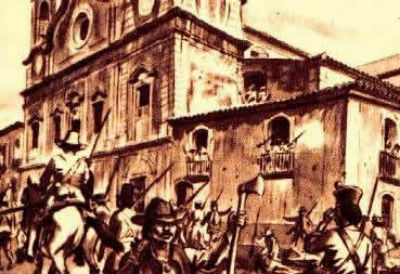THE cabin it was an extremely violent popular revolt, which took place from 1835 to 1840, in the province of Grão-Pará.
The rebellion was aimed at the independence of the region.
Historical context
In the years 1835-1840, the Empire of Brazil lived the regency period.
Dom Pedro I had abdicated in favor of his son who was only five years old. Therefore, the regency was instituted to govern the country.
However, several provinces were not satisfied with centralized power and wanted more autonomy. Some even wanted to separate from the Empire of Brazil.
Insurrections such as Farroupilha, Balaiada and Sabinada exploded throughout Brazilian territory.
Province of Grão-Pará

Map showing the province of Grão-Pará, in red
The province of Grão-Pará comprises the current states of Amazonas, Pará, Amapá, Roraima and Rondônia.
Grão-Pará had more contact with Lisbon than with Rio de Janeiro. Therefore, it was one of the last to accept independence, only joining the Brazilian Empire in 1823.
The Cabanagem Revolt had a considerable reach and spread along the Amazon, Madeira, Tocantins and its tributaries.
Interestingly, the name of this movement is a pejorative term and refers to the typical houses of the province, built as "cabanas" or "palafitas".
Main causes
Among the main causes of the revolt we can point out:
- Political and territorial disputes, motivated by the elites of Grão-Pará;
- the provincial elites wanted to make the political-administrative decisions of the province;
- neglect of the regency government towards the inhabitants of Grão-Pará;
- the cabanos, for their part, wanted better living and working conditions.
It is worth mentioning that, in this regard, the aforementioned elites took advantage of popular dissatisfaction to raise the populations against the regency government.
The uprising
Since Brazil's independence in 1822, the elites of Grão-Pará resented the presence of Portuguese traders in the province.
In the government of D. Peter I, owners and traders were dissatisfied with the treatment received by the central government.
In addition, they suffered from the repression of the Governor Bernardo Lobo de Sousa since 1833, he ordered arbitrary deportations and arrests for anyone who opposed him.
So, in August 1835, the cabanos mutinied, under the leadership of the farmers Felix Clemente Malcher and Francisco Vinagre, culminating in the execution of Governor Bernardo Lobo de Sousa.
Then they nominate Malcher for president of the province. On that occasion, the rebels seized the legalistic armaments and strengthened themselves even more.
However, Clemente Malcher reveals himself as a faker and tries to repress the rebels, ordering them to be arrested Eduardo Angelim, one of the leaders of the movement. After a bloody conflict, Malcher is killed by the "cabanos" and replaced by Francisco Pedro Vinagre.
In July 1835, the then president of the newly conquered province, accepts his surrender through the general amnesty of the revolutionaries and for better living conditions for the needy population. However, he is betrayed and arrested.

The fight in Praça da Sé was one of the bloodiest in Cabanagem
Discontented, his brother, Antonio Vinagre, reorganizes the military forces of the hut and attacks the Palace of Belém, conquering it again on August 14, 1835.
On the occasion, Eduardo Angelim is made president of an independent republican government. However, the disagreement among the movement's leaders weakened the revolt and facilitated the legalist counterattack.
Thus, in 1836, sent by Regent Feijó, the Brigadier Francisco José de Sousa Soares de Andréa, chief commander of the regency forces of Grão-Pará, authorizes total war on the cabanos. He orders the bombing of Belém and the settlements of the hut.
In this way, with the help of foreign mercenaries and imperial soldiers, the revolt is put down. Eduardo Angelim is captured and sent to Rio de Janeiro.
Finally, in 1840, most of the insurgents had already dispersed or had been arrested and killed, due to persecution, which continued even after 1836.
With the rise of Dom Pedro II to the throne in 1840, the prisoners were pardoned.
Consequences
Although the persecution was violent, some revolutionaries managed to escape and fled into the forest, which allowed the hut's ideals to survive even after their defeat.
The Cabanagem left a carnage of more than thirty thousand dead, almost 30 to 40% of the population of the province. It decimated riverside populations, quilombolas, indigenous peoples, as well as members of the local elite.
It also disorganized the slave trade and quilombos multiplied in the region.
Curiosities
- The women were fundamental in the Cabanagem, as they were the ones who brought information and food to the revolted gang.
- Cabanagem was one of the few revolts of the regency period that brought together various social classes.
- In Bethlehem there is the Cabanagem Memorial that houses the remains of the leaders of the revolt.
- In 2016, Cabanagem inspired a musical, written by Valdecir Manuel Affonso Palhares and with music by Luiz Pardal and Jacinto Kahwage.
Also read:
- War of the Rags
- sabinada
- Malês revolt
- Governing Period
- Brazil Empire
- State of Pará

